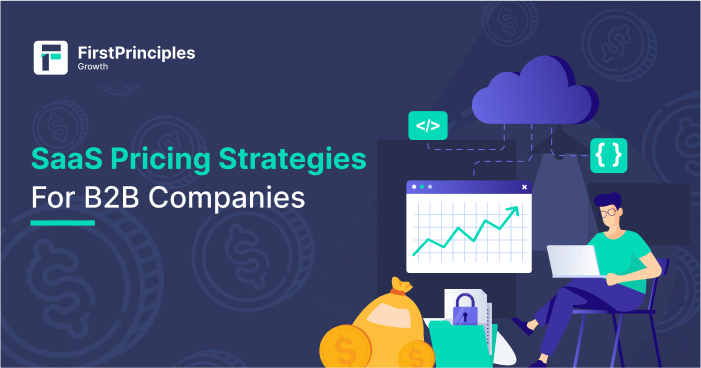
Home > SaaS Pricing Strategies For B2B Companies
Table of Contents
Toggle
It’s needless to say that every business needs incoming cash flow to survive. That’s pretty obvious, isn’t it? This makes Pricing strategies crucial for your business as they possess the power of making or breaking your business. Higher prices can repel your potential customers and lower can pricing can lead to false perceptions about the product and also affect your overall revenue.
So first things first, you need to understand that “Pricing is a function of Marketing”. Coming up with a pricing strategy for your SaaS product requires a lot of thinking as it’s not a one-time job.
While coming up with a pricing strategy for SaaS products, you need to keep in mind that it’s not static but dynamic in nature, i.e., it is ever-evolving and changing like your Marketing Strategy and the SaaS pricing strategies depend on the Market Forces, Feedback from customers, etc.
According to Price Intelligently, enterprise pricing models have a huge effect on the overall revenue generated by a SaaS company. In fact, about a 1% improvement in SaaS price optimization can result in 11.1% more profit.
Before coming up with a pricing strategy, you should know what objectives you want your pricing strategy to serve.
So the first thing you need to know is what is a pricing objective and how you can set it for your business.
In this blog, we try to cover what pricing strategy is and how you can design and implement it for your business.
You can consider Pricing Objective as a compass that acts as a guide for your pricing strategy and ultimately helps you achieve your goals.
When we talk about a Pricing Objective, what’s the first thing that pops in your head? Profit.
That’s obvious. Every business wants to generate huge profit and this is especially crucial for a SaaS business.
While coming up with a pricing strategy just remember that it is a profit-maximizing decision. It is the lever of your business growth and reflects and affects everything you do as it is the heart of a SaaS business.
An optimal pricing strategy takes your costs (fixed and variable), demand, competitors, and buyer personas into account.
Here are a few prerequisite steps that can help you identify the best and most suitable SaaS pricing strategy for your product
If you have a competitor whose product is similar to that of yours and is successful too, you can keep their price point at the threshold value and vary your price around that. Higher or Lower will depend on the features of your product, and if you’ve any add-ons.
The second thing will be feedback from your customers. For this, you can conduct a survey asking them what they would pay for a product like yours.
Last but not the least, you’ve to always remember that pricing strategies are dynamic in nature, and you might need to test a few before you understand what works the best for you. In the SaaS industry, you need to discover your own truths.
To help you choose a better pricing strategy, we have enlisted 6 pricing strategies
Implemented by companies like Slack and New Relic, Penetration pricing is a strategy where you can keep can enter the market with lower prices, and once you’ve found the relevant market segment you can go raise the price. It’s just in order to rapidly gain adoption in your target market.
This strategy works on 2 beliefs:
This strategy is sometimes used by companies in order to crush their competitors.
Selling your base product at an inexpensive price or maybe giving it away even for free and then later charging for upselling, that’s what captive pricing is all about. It’s pretty obvious from its name too. Captive- to capture and that’s exactly what the company does. Here you can consider the example of Dropbox – which offers a certain amount of storage for free and later charges you when you need additional space.
You can also consider the example of LinkedIn – A free professional networking platform where you can send In-mails to people within your network and to reach out to people outside that you need to upgrade to the Premium version.
Skimming pricing or promotional pricing is a strategy where a company initially sets a high price for its product(mostly when they’re not sure about their price) and they gradually start decreasing their prices. This strategy is generally followed by companies when they launch a new product in the market and is found to be appealing to different subsections of the marketplace.
The best example would be Apple products – they are famous for offering heavy discounts just months after their launch.
Prestige or premium pricing is a strategy of playing with the customer’s psychology, that “Good things are expensive”. Companies deliberately keep their prices high in order to convey a sense of high quality or luxury. With this strategy, companies will have a small customer base but a high-valued one.
If your brand is well-known or your product is used by some popular companies, then you might be able to leverage this pricing strategy.
The best pricing strategy example to state here will be Rolex.
Although a $40 Seiko watch is a better time-piece and is far more accurate than $8,000 Rolex, due to its brand name Rolex is able to leverage the prestige pricing.
Free trials are always appealing to customers and that’s what companies using free trial pricing focus on. They provide their product free for a limited time and obviously their trick works. I mean, who doesn’t like free things? Customers start using your product without even spending a penny from their pockets but once the trial period ends there’s a strong incentive to upgrade. It’s mostly like a trial period. Companies are increasingly using this strategy. Such trials are typically time-limited – 7 days, or a month. Companies like Netflix, Coursera have implemented this strategy.
Here the perceived value of the product is used to determine a benchmark for price setting. Here the customer data is utilized and the entire focus is how the customer will respond to the product. Although this strategy isn’t a quick win but has a better LTV(Lifetime Value). In simple words, it’s the idea that the value your product provides should be ten times its price, providing a simple method for framing your pricing decisions.
Pricing is like a black box that can be illuminated through a process only. Take and utilize the knowledge we shared, apply whatever’s useful but systematically. Make sure that your LTV to CAC ratio is greater than 1, otherwise, you’re losing an enormous amount of money, and that will hurt you.
Heebatullah
Technical Content Strategist and Inbound Coordinator at FP Growth, Heba is a motivated self-starter with a knack for analyzing and solving tough business problems. When not working, you can find her either reading a book, painting landscapes or sketching places she yearns to visit one day.